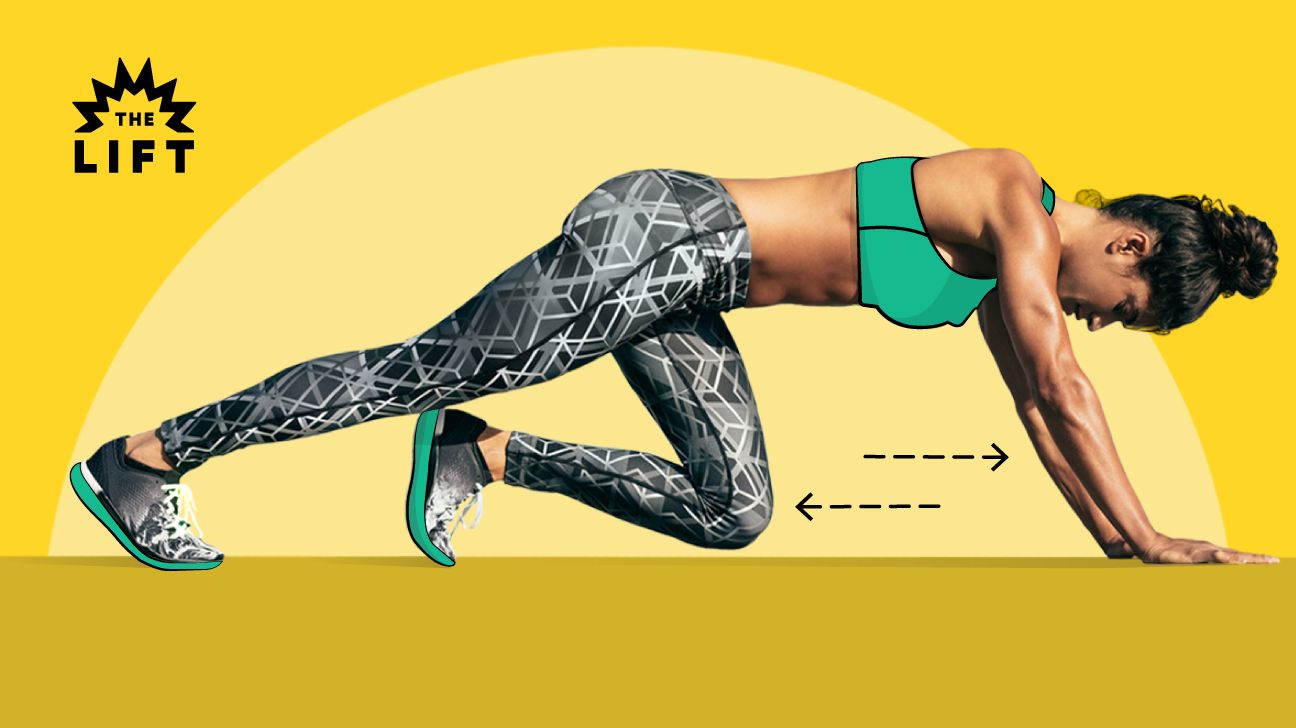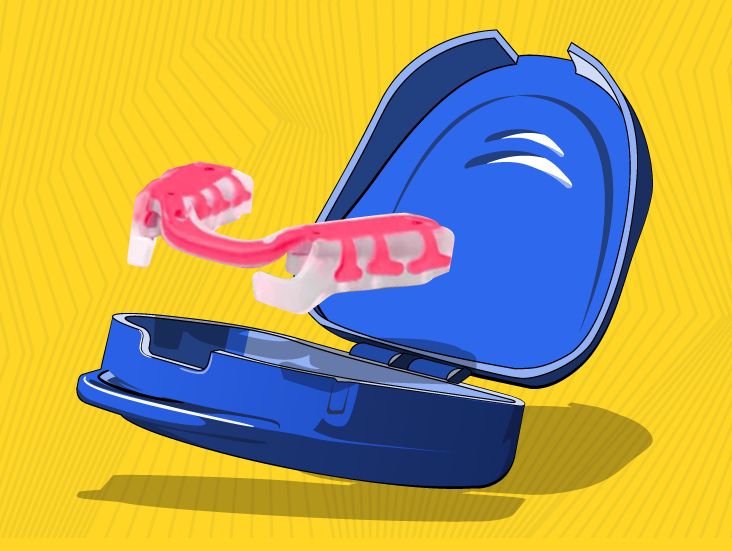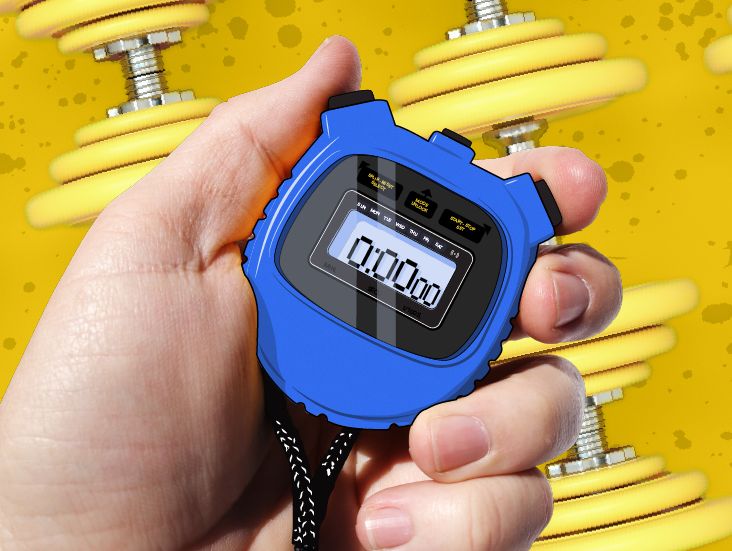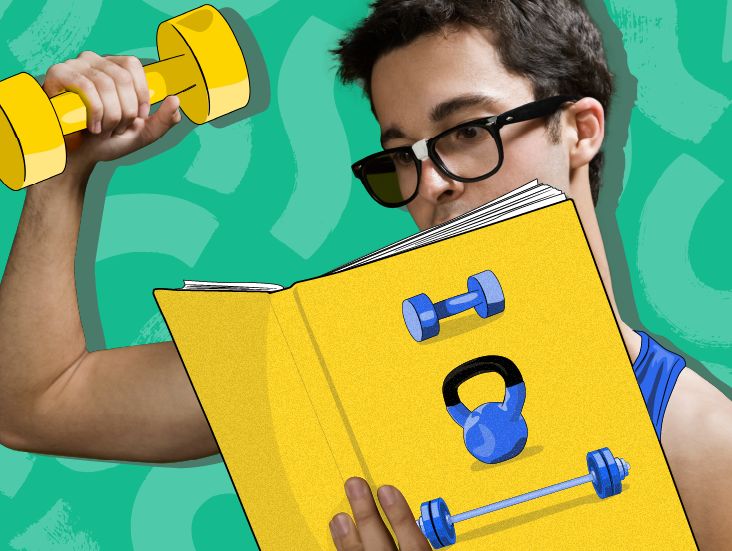
Mountain climber. Mountain climber. Mountain climber.
Yeah, it sounds like a stale nickname for a Patagonia enthusiast, the name of a cover band for the oh-so-underappreciated Mountain Goats, or Jeep’s latest ~outdoors~ model.
But it’s actually an exercise — and a rather good one at that.
Visualize yourself running in place. Now, visualize yourself running in place while in a high plank position. More or less, that’s a mountain climber.
How to do a mountain climber
- Start on all fours, with wrists directly under shoulders and fingers spread, gripping the floor.
- Place your feet hip-width or shoulder-width apart (whichever is wider).
- Engage your core by trying to get belly button to “touch” spine.
- Create tension throughout your body by pulling up on quads, squashing your bum cheeks together, and rotating pinkies toward heels without lifting them.
- Without tilting to one side or the other, draw your right knee up. Then, step it back.
- Draw your left knee up, and then step it back.
- Continue alternating legs.
Can you translate, please??
Wondering exactly how far up you should draw your knee? The answer varies based on your fitness goals.
For the really intense: Draw your knee directly below your nipple on the same side. This variation will improve your cardiovascular capacity.
For those who want to improve core strength: Either draw your right knee to your right elbow (intermediate level) or to your left elbow (advanced level).
For those aiming for improved hip mobility: Rather than shifting your knobs AFAP (as fast as possible), slow down.
“Drawing your knee towards your elbow so that your foot is right next to your planted hand is an awesome way to open up your hip flexors, hip abductors, and hip adductors,” says physical therapist Grayson Wickham, founder of Movement Vault.
Basically, turn it into a runner’s lunge.
Mountain climbers have many benefits beyond their versa-f*cking-tility!
Cardio — anywhere, anytime
“Mountain climbers are a great substitute if you don’t have a cardio machine at your house and don’t know the area well enough to go on a run,” says certified strength and conditioning coach Mia Nikolajev, who also competes in powerlifting. “You can literally just drop to the ground and run right in your room.”
Just be sure to do your carpet a solid and lay down a sweat rag first. A few minutes of mountain climbers will drench ya.
Full-body burn
Mountain climbers are a full-body workout. Nikolajev notes that the exercise can work your:
- core
- obliques
- triceps
- shoulders
- glutes
- quads
- hamstrings
- hips
- calves
But she warns against letting your technique slip. “If you get lazy while doing the movement and don’t actively engage your muscles, mountain climbers aren’t going to work any of those.”
Boosted balance
The perks of a muscle-clad midline thanks to mountain climbers go far beyond aesthetics, according to Wickham.
“The stronger your core, the better your balance and stability are,” he says. “Plus, the core muscles are designed to protect our lower back, so the stronger your core, the lower your disc and back muscle injury risk is.”
Overall reduced injury risk
This deserved to be seconded. Because no matter your fitness goals, it’s pretty darn tough to get after them while nursing an injury.
Guess how many of these benefits (^) you reap if your form is (to put it bluntly) trash? Zero. Zip. Zilch.
As the saying goes, you reap what you sow sweat. So, avoid the following as you clamber and climb.
Letting your lower body snooze
If you prioritize speed over form, mountain climbers are going to primarily work your quads.
But, Nikolajev notes, “If you pause halfway through every rep and squeeze your butt and hamstring when your knee is bent and raised, you’ll work those muscle groups too.”
Humping the floor
The sexuality professional in me L-O-V-E-S that you’re giving grinding the attention it deserves. But my inner fitness professional has a request: Please quit doing so while you’re working out!
“Crotch drop is a sign that your core isn’t actively engaged while you’re moving,” says Nikolajev.
Lack of core engagement = increased lower-back injury risk.
So if you feel your junk dropping to the floor or you can see that your lower back is rounded, stop. Breathe.
Then, return to the high plank position, this time actively pulling your belly button into your spine. From here, you’re welcome to reincorporate your legs.
Putting your bum in the air
Some folks’ hips are way too high.
“You should not be in a pike position while doing mountain climbers,” says Nikolajev.
The fix: Engage your core.
Traveling hands
Attention, beginners and intermediate mountain climbers: Your wrists should be stacked directly under your shoulders.
If you can do 60 seconds of mountain climbers with damn good form *and* have the strength to crank out 15 strict push-ups, you can level up to advanced mountain climber territory.
According to Nikolajev, you can increase the difficulty either by walking your hands closer to your toes or by walking your hands farther in front. Both options crank up the shoulder, triceps, and core activation.
But (and this is very important!) if you let your hands drift forward or backward before you have the strength to do so, Nikolajev says, “You’re going to get shoulder pain, wrist pain, or lead to injury.”
Wonky elbows
“You want your elbows pointed back, but you don’t want them locked,” says Nikolajev. Once your legs get in on the action, she recommends actively pressing your fingers into the floor and pushing your palms away from the floor.
This, she says, will protect your elbows and engage your pecs.
Rather than hopping on a treadmill or rower to warm up, hit the floor and rep out 30 to 50 mountain climbers. Because they’re a full-body exercise, you’ll be ready to take on just about any workout routine after that.
Another option: Do mountain climbers Tabata-style. Tabata is a high intensity workout that involves doing 8 rounds of 20 seconds on, 10 seconds off. Trust: When the 4 minutes are up, you’ll be POOPED.
Yes-sir-ee.
If you can maintain good form while going faster or climbing for longer, Nikolajev gives you the green light to do just that.
If strength is your goal, you might do mountain climbers while holding on to a pair of nonrounded dumbbells (grip!) or while wearing a weight vest (core!).
No sweat — just elevate your hands. All you need is a bench, box, or wall.
Set up as if you’re going to do a push-up: wrists in line with shoulders, core braced, glutes tight, and gaze neutral.
Next, alternate drawing your knees up to belly-button height, one at a time. Go as slow as you need to maintain a tight core.
You can also try dropping from your hands to your forearms. This will relieve some of the tension on your upper bod. You won’t be able to pull your knees underneath you from this position, so bring them to the outsides of your elbows instead.
The bottom line: As Nikolajev puts it, “The mountain climber is a great exercise, and regressions and progressions mean the movement is accessible for everybody.”
Gabrielle Kassel (she/her) is a queer sex educator and wellness journalist who is committed to helping people feel the best they can in their bodies. In addition to Healthline, her work has appeared in publications such as Shape, Cosmopolitan, Well+Good, Health, Self, Women’s Health, Greatist, and more! In her free time, Gabrielle can be found coaching CrossFit, reviewing pleasure products, hiking with her border collie, or recording episodes of the podcast she co-hosts called Bad In Bed. Follow her on Instagram @Gabriellekassel.





